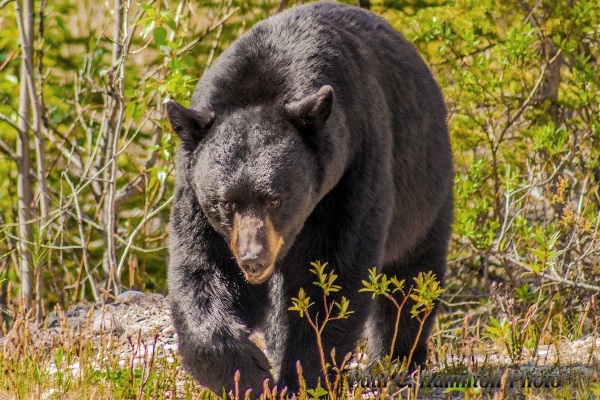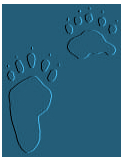(Ursus americanus) BLACK BEAR
Size of Jasper Alberta's Black Bears
- Mass: 120 to 250 kg (256 to 550 lbs.)
Length: 5 to 6 ft. - Wildlife living area: taiga, temperate forest & rainforest, chaparral, mountains
Range: The black bear can be found from northern Alaska east across Canada to Labrador and Newfoundland, and south through much of Alaska, virtually all of Canada, and most of the U.S. into central Mexico (Nayarit and Tamaulipas states). - Black bears once lived throughout most of North America, but hunting and agriculture drove them into heavily forested areas. Residual populations survive over much of the range in sparsely populated wooded regions and under protection in National parks. They are numerous and thriving.
Berry Season is a Time For Extra Care
It is Berry Season now and that means a time to be Extra Careful when out in Favorite Shared Spaces. Bears can become very focused on eating Berries and when in dense bush, Surprise Encounters are Far More Common. If a Bear knows you are there, or approaching on a trail, the chances of a difficult situation is less likely. Be Safe out there!
Tiny Bear Cubs in the Rain
These tiny newborn Bear Cubs were in a tough area with little food for Mum for much of the Spring, but have now found a much better spot with lots of lush green area recently nourished by the rain. This new area not only offers more nutrition, but much more dense forest will provide increased safety for Mum's tiny Cubs. It does not get much Cuter than tiny playful Bear Cubs in Nature.
A Rare Bear Family - Newborn Cub, Older Sibling and Beautiful Mother
This Brown Phase Mother Bear not only brought out her newborn cub very early, but is also still in the care of her yearling cub. A very rare occurrence that we will not expect to witness again any time soon! Hopefully the little one is getting lots of Mum's Milk to grow stronger fast. The initial worry was that this tiny Bear Cub was stuck or injured, as it's sibling whizzed up and down the tree in such close aggressive proximity. This was a high human activity area that was extra tricky for all, however the Cub did come down and they may have found a much safer space by now.
Canadian Rocky Mountain Bear Cubs in Nature

First Black Bear Encounter in 2020 - April 19th
Where do Black Bears Live?
Tiny Bear Cubs among the Paintbrushes 2019
New Bear Cubs of the Year in Canada's Rockies 2019
Colors of Canadian Rockies Black Bears
Below is a Trio of colors in one Black Bear family. Black bears come in more colors than any other North American mammal. They can be black, brown, cinnamon, blond, blue-gray, or white. The melanin in black fur makes the Bear's fur more resistant to abrasion, while light colored fur reduces heat stress in open sunlight and allows the bears to feed longer in open, food-rich habitats. Black fur dominates in areas that are mostly under forest cover, while brown, cinnamon, or blond is seen more in bears that inhabit open forest meadows. Lighter colored fur may camouflage Bears and Cubs from predators in open areas better.Trio of Colors in one Canadian Bear Family

Newborn Black Bear Cubs and Mum During a Heat Wave
These Newborn Black Bear Cubs(Cubs of the Year) did a good job of avoiding the Grizzly Bears in the area this Spring and Summer. The Heat wave was unavoidable, however. Many of the Adult mother Bears we have seen are much lighter than they might normally be right now and She shows it here. The Tiny Black Cub also seems to have been favoring a front paw both in June and July, but it did not seem to affect it's tree climbing ability. We hope these adorable survivors and this area of Canada's Rockies benefit from some much needed rain in the very near future.
Bear Cubs Zipping Up and Down Trees then Nursing in Jasper
Black Bear Nursing Cubs at Dusk in the Canadian Rockies
What do Black Bears Eat just out of Hibernation?
Young Adult Black Bear Just out of Hibernation Eating Poplar Buds 2018
Jasper Wildlife - Bear Cubs of the Year at Play
Black Bear Siblings Getting Rough with Eachother
Details on Black Bears in Jasper
Front paw track ranges from 4 to 5 inches in length (10 - 13 cm); human-like rear track is from 6 to 9 inches in length (15 - 18 cm). Black Bear tracks can be differentiated from the Grizzly Bear by evidence of smaller claw markings in the Black Bear print.

Black Bear Tracks
